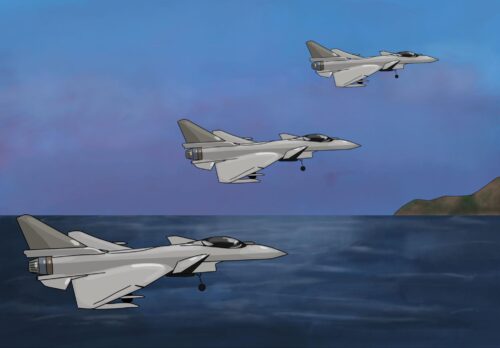China’s military industry is booming with huge demand for combat equipment
As a big merger takes place between two state-owned aviation equipment companies, the 14th Five Year Plan is propelling huge demand in the military industry — along with a crucial change of emphasis.

In the last week of May, a major event in China’s military industry was reported by the Chinese business press that has been ignored by the English-language media: Two subsidiaries of Aviation Industry Corporation of China (AVIC) 中国航空工业集团, a state-owned defense contractor and supplier of fighter jets to the People’s Liberation Army (PLA), announced a merger via a share swap deal.
The two companies — China Avionics Systems 中航航空电子系统 and Avic Electromechanical Systems 中航工业机电系统 — will be reorganized into one large listed firm that will be the biggest domestic producer of airborne systems, i.e. microelectromechanical and electronic systems used on aircraft, satellites, and spacecraft.
The day after the announcement and in the week since, the share prices of both companies have risen sharply, as did the whole military sector, with various stocks reaching their daily limits. In fact, China’s military industry is positively booming.
The 14th Five-Year Plan period (2021-2025) is witnessing a significant expansion in the scale of orders and production of military industrial enterprises, with especially high demand for aircraft carriers, large aircraft, maritime equipment, and aircraft engines.
- According to one estimate, 101 listed domestic military industry companies reported total revenues of 509.4 billion yuan ($76.28 billion) in 2021, a year-on-year increase of 12.79%, and net profits of 29.8 billion yuan ($4.46 billion), a year-on-year increase of 9.07%. These growth trends have continued apace in the first quarter of this year.
- From the first quarter of 2021 to the first quarter of this year, the net profits of ten listed military industry companies, including AVIC Heavy Machinery 中航重机, Kingsignal 金信诺, China Zhenhua Group 振华科技集团, and North Navigation Control 北方导航, increased by more than 50% year-on-year.
- The Military Industry Index, tracking the leading Chinese military industry listed companies, has recorded inventory increases for the last three years. As of May 23, the index included 64 stocks with an average capitalization of 25.73 billion yuan ($3.85 billion). Average net profit growth for 2022 and 2023 is forecast to be 39.62% and 23.73%, respectively.
- Xi’an Triangle Defense 三角防务, a manufacturer of forgings for the military industry, in the first quarter reported revenues of 428 million yuan ($64.09 million), a year-on-year increase of 127%, and net profits of 142 million yuan ($21.26 million), a year-on-year increase of 90%.
This year, companies in the military industrial and equipment chain have reported large increases in orders (from unnamed clients), for example (from various parts of the military industry chain):
- Guide Infrared Group 高德红外集团, a manufacturer of military electronics, announced at the end of March that it had signed a contract of 269 million yuan ($40.28 million) for infrared thermal imaging devices.
- Sinofibers Technology 中简科技, a supplier of carbon fibers and fabrics for the aviation industry, reported in March that it had signed a big sales contract of 2.16 billion yuan ($324.82 million), which accounts for 556.94% of the company’s revenues in the last fiscal year.
- Earlier this year, Kuangchi 光启技术, a company that operates in the aerospace, communications, and AI industries, announced it had signed a contract of 1.98 billion yuan ($297.57 million) to supply metamaterials (i.e. artificially engineered materials with customizable properties) for the aviation industry. This single contract accounted for 321% of the company’s total revenues in 2020.
The context
The merger of China Avionics Systems and Avic Electromechanical Systems is part of a three-year reorganization of China’s state-owned enterprises (SOEs) that commenced in 2020.
What Beijing has dubbed a “crucial stage” for SOE reform is intended to make SOEs more competitive with a clear alignment in the various sectors to avoid resource dispersion and horizontal competition. Now in its final year, the process has kicked into high gear: According to one data set, as of May 17, there have been 28 major restructurings of centrally-controlled listed SOEs, and 44 of local listed SOEs so far this year, representing growth rates of 267% and 250% year-on-year, respectively.
As part of the reform process, regulators are giving executives more autonomy in making corporate decisions, and are allowing SOEs to seek non-state capital, including from private or foreign sources. In addition, the reform also entails a blending of state and non-state enterprises to make industrial chains more resilient. Since 2013, according to the State-owned Assets Supervision and Administration Commission (SASAC), SOEs have become shareholders in more than 6,000 private domestic companies.
The military sector is also being boosted by the government’s military-civil fusion (军民融合) strategy. First proposed in the 1990s, military-civil aims deregulate China’s defense industry by encouraging the private sector to invest in and manufacture military equipment.
The takeaway
Xí Jìnpíng 习近平 has frequently called for the transformation of China’s armed forces into a “world-class military that is ready to fight and win wars.” This is propelling an historic evolution in China’s military industry towards demand for equipment for actual combat.
This has brought about fundamental changes for military industry manufacturers, not least a huge increase in new orders. Combat training is accelerating the consumption of weapons and components, as well as the various industries needed to replace and maintain such equipment.
It may not bode well for the world, but China’s military companies have very bright prospects.






